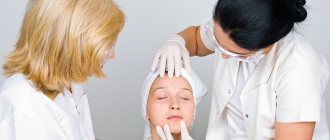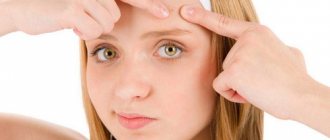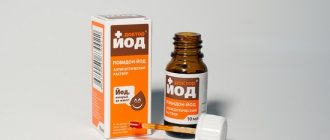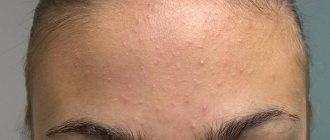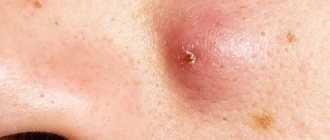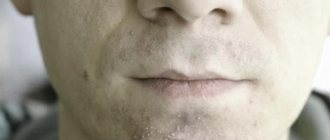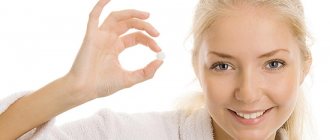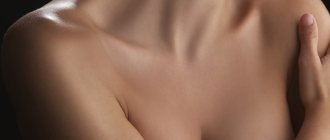Direct connection between acne and hormones
Androgens are responsible for the production of skin secretions using the sebaceous glands. Androgens regulate all processes in skin cells, hair follicles, and dermis. In addition to the production of sebum, androgens lead the process of keratinization and cell division of the epidermis.
The liver is responsible for removing toxins from the body. If there is excessive production of hormones, they actively move through the systems. The liver is unable to cope with the excessive load and begins to remove impurities through the skin. Pimples appear.
Testosterone is a male hormone, but it is also present in small quantities in the female body. When for certain reasons its quantity increases, the sebaceous glands secrete more sebum. Sebum mixes with dead skin cells, impurities and clogs pores. The lard interacts with oxygen, oxidizes and turns black. In ordinary life, we see the result of this process in the form of black dots on the face. If nothing is done, bacteria continue to multiply and divide, resulting in acne formation. Thus, acne due to hormonal imbalance is really a big problem. Hormones are very sensitive and minimal factors accompany their imbalance.
Acne during hormonal imbalance occurs not only on the face. They also affect the back, shoulders, and chest.
Types of acne
Acne caused by hormones can be different. Doctors distinguish several types of acne:
- A comedon (white pimple) is a sebaceous plug that clogs a pore. It often causes inflammation. They are closed and open. In the second case, the plug is not located inside the pore (black dot). Fat deposits form in the deep layer of the skin. They are quite difficult to remove;
- papule - it develops after an infection attaches to the sebaceous plug. In this case, the affected area of the skin turns red. If you press on it, the person feels discomfort and pain;
- pustule is a type of acne that contains pus. It is localized on the surface of the skin in the form of a white dot;
- nodular cystic acne - they are a group of small formations that are connected to each other by fistulous ducts;
- fulminant - they are considered the most severe form of pathology, as they affect large parts of the skin. The result of the development of such a rash is an increase in temperature and painful sensations. Without qualified medical help, it is almost impossible to cope with the pathology.
If any of the above types of acne appear, you must consult a specialist.
Factors that cause hormonal imbalance
Scientific studies have shown that hormone disruption occurs for certain reasons. There is no point in trying to find the cause of hormonal imbalance on your own. It is better to entrust this to a doctor. There are natural and acquired causes of hormonal imbalance. Most often, hormone failure occurs due to one’s own fault:
- Wrong lifestyle. Overwork at work, chronic lack of sleep and fatigue prevent a woman from recovering calmly. At such moments, in addition to acquiring depression, you are also at risk of hormonal imbalance.
- Unbalanced diet. Addiction to diets leads to the fact that the body does not receive the normal amounts of minerals and vitamins necessary for the synthesis of hormones. At the same time, overeating, indulgence in fatty foods, alcohol, and smoking slow down the normal processes of hormone production.
- Severe stress provokes the production of androgens. They turn on sebum production and start the chain of acne. Under stress, the body's protective and restorative functions are weakened, and acne appears again and again with full activity.
- Colds and venereal diseases (gonorrhea, syphilis) reduce the body's immunity and defenses, which leads to hormonal imbalance.
- Use of strong medications, steroids, and contraceptives. All medications must be strictly prescribed by a doctor. Acne due to hormonal imbalance from steroid use appears as nodular, cystic formations with cloudy contents. To treat such acne, it is enough to simply remove this drug from your lifestyle.
- Lack or excess of sex. It has long been established that when having sex, the body produces hormones that contribute to the normal state of human life. Hormonal levels and lovemaking are closely related, which is why acne formation is also present here.
Progesterone causes hormonal acne
Yes, fluctuations in progesterone levels during the monthly menstrual cycle can also cause acne to appear before your period begins.
Acne in women of reproductive age. How to deal with it
Progesterone levels rise during the middle of the cycle. This can stimulate increased sebum production from the sebaceous glands in the skin. Elevated progesterone can also cause swelling of the skin and constriction of skin pores. This causes sebum to accumulate under the surface of the skin. Increased sebum along with dirt, dead skin cells and bacteria leads to an increase in acne before and during menstruation.
Causes of hormonal disorders that are beyond a person’s control
Some periods of life are a natural cause of hormone surges. We cannot control them, as they are part of a woman’s life. These reasons include periods:
- Menses. In the first phase of the cycle, estrogen dominates, in the second - progesterone. In the last phase, you can see an increase in the amount of testosterone, which leads to acne. The number of rashes varies for each woman and depends on skin type and hygiene. The rash usually goes away on its own within a few days.
- Postpartum period. In the first weeks after the birth of the baby, the female body is in a state of estrogen deficiency. Progesterone is the leader and causes hormonal imbalance and acne.
- Menopause. During this difficult period in a woman’s life, estrogen decreases due to decreased activity of the adrenal glands. Even though women are mature, they can still see pimples on their face. It is necessary to consult a gynecologist so that he can prescribe a drug that compensates for estrogen.
In addition to natural causes, hormonal imbalances also occur due to dysfunction of internal organs. Pituitary gland disease is one of the causes of hormonal imbalances. The pituitary gland increases in size due to a lack of iodine in the body and hormonal surges are observed.
Adrenal gland dysfunction, especially tumors, leads to facial acne due to hormonal imbalance. The adrenal glands are known to be responsible for the production of estrogen.
Diseases of the pelvic organs and groin area negatively affect hormones. Ovaries and acne on the face are inseparable concepts. Ovarian tumors or polycystic ovaries affect the normal balance of hormones.
Therefore, in addition to visiting a dermatologist, every adult should consult an endocrinologist, gynecologist or urologist in case of frequent acne on the body. Acne may not be a dermatological problem, but a consequence of problems with internal organs.
Features of treatment and prevention
If hormones negatively affect the condition of a person’s skin, the pathology can only be dealt with by balancing them. It is important to follow the right diet, which will contain a minimum of sugar and fat.
Treatment should be prescribed not only by an endocrinologist. All systems in the body are closely interconnected, so a person will need additional consultation with a gynecologist (female) or andrologist.
You should not hope that the result of treating hormonal acne will be quick, because achieving the necessary balance is not so easy. General therapy includes the following actions:
- taking medications - it is important to strictly follow the dosage, duration and time of administration, and doctor’s recommendations. Typically, such therapy is carried out in courses. The treatment is long-term and specific. The most commonly used drugs are Baziron and Metrogyl. Women are recommended to use oral contraceptives. They not only normalize the condition of the skin, but also improve the menstrual cycle. In the vast majority of cases, such treatment can completely cope with the problem;
- local medicines - they are an excellent addition to internal treatment. Creams and ointments should be selected by a cosmetologist who is familiar with the opinions of other doctors. For facial care, lotions, tonics, moisturizing and nourishing creams are prescribed for daily care. Most often they contain zinc or salicylic acid;
- iodine can be used to treat inflamed acne that is not located on the face. It helps tumors mature faster and also prevents their further infection;
- the use of folk recipes - nettle infusion is considered very popular. To prepare it you need 2 tbsp. l. raw materials and 0.5 liters of boiling water. The mixture is infused for 2 hours. You should drink half a glass 3 times a day before meals. It is necessary to be treated in this way for at least a month;
- cosmetic facial cleansing – it must be professional. It is necessary to take into account the characteristics of the body and the diagnosis. It is best to do it in a beauty salon, otherwise unsightly scars will remain on the skin.
As for prevention, everything is simple: you need to use daily cleansers specially designed for problem skin, periodically make cleansing masks, and apply scrubs. You can also apply anti-inflammatory masks based on medicinal herbs to your face.
You should give up important habits and adjust your diet. It is advisable to take all possible measures to strengthen the immune system.
Features of hyperandrogenism
Hyperandrogenism, in other words, an excess of sex hormones, has pronounced symptoms. In addition to acne on the body, you can observe:
- Increased hair growth in women;
- Acne cannot be treated;
- Low timbre of voice in females;
- Rapid weight gain;
- Reducing breast size.
Less pronounced signs of hormonal imbalance may include severe fatigue, irritability, decreased libido in the fair sex, irregular periods, frequent headaches and pressure surges, and sweating. These signs are difficult to notice and link into one cause. We don't look at it as a symptom of a disease and then treat the dire consequences. To avoid this, listen to your body, give yourself time to rest and reboot.
How to treat hormonal rash
When treating, the reasons that influenced the formation of the rash should be taken into account. If acne appears during a woman’s menstruation, this is a periodic phenomenon that does not require treatment, only proper, complete and balanced nutrition.
If the rash spreads across the skin, treatment is required.
To completely get rid of hormonal rash, you need comprehensive treatment and patience, since it will take a lot of time.
For small pimples located in the T-zone, also in the abscessive stage, treatment can be carried out at home, with the help of proper nutrition and simple cosmetic procedures.
This will ensure your skin stays healthy. In cases of severe damage with deep and painful skin rashes on the face, back and chest, consultation with a doctor and taking medications are required.
Experience treating hormonal acne, watch this video:
In addition, it is recommended to undergo testing for the level of hormones in the blood to identify which hormones lead to the appearance of pimples on the skin. Laboratory tests will help with this, based on the results of which the doctor will be able to prescribe appropriate medications.
After taking the necessary medications, the functioning of the sebaceous glands should normalize and the hormonal levels should stabilize.
As a rule, doctors are in no hurry to prescribe medications, since many have contraindications and side effects. The following steps will help bring your hormonal levels back to normal:
- Maintain a balanced, healthy diet;
- Maintain a proper daily routine with proper rest and sleep;
- Lead a correct lifestyle;
- Try to avoid stressful situations, receiving only positive emotions.
Treatment depending on the degree of rash
The course of treatment is prescribed depending on the reasons that influenced the appearance of acne, as well as the severity of the rash:
- If there are no more than ten elements of the rash on the skin with virtually no symptoms of inflammation, they speak of mild acne. Treatment in this case is carried out with local therapy drugs, the active substances of which either prevent the appearance of acne or contribute to their destruction. These are various gels, creams, lotions.
- If more than ten to thirty rashes appear on the skin, they are classified as moderate acne. In this case, it is necessary to use not only external preparations, but also oral preparations.
- When more than forty rashes appear on the skin, severe acne is considered. Treatment is prescribed according to the reasons; antibacterial or hormonal therapy may be prescribed.
In extreme cases, with suppuration and severe inflammation, the lesions are injected with special preparations. It should be borne in mind that with a hereditary predisposition to acne, acne is quite difficult to treat.
As a rule, the treatment course is aimed at preventing further spread of the rash and the development of a chronic form of the disease.
How to avoid hormonal rashes
You can improve the condition of the skin of the face and thereby normalize the functioning of the sebaceous glands, reducing the likelihood of this by properly caring for the skin. First of all, it is following simple rules:
- Wash your face at least 2 times a day, using foams and gels for washing;
- Try not to overuse cosmetics.
- It is recommended to visit a cosmetologist twice a month and have the skin of your face professionally cleansed.
- Regular visits to the bathhouse will help to steam your skin well, open and cleanse your pores.
- Maintain a proper diet.
- Take a course of multivitamins.
The main thing is to never squeeze out pimples and blackheads, so as not to cause an infection and provoke the development of an inflammatory process.
Treatment of acne caused by photodermatosis
It is recommended to treat photodermatosis with the following means:
- "Advantan";
- "Fluorocort";
- "Lassara";
- "Flucinar";
- "Oxycort";
- "Lorinden";
- "Suprastin";
- "Claritin."
It is recommended to treat a persistent form of the disease with the following means:
- "Fenistil - gel";
- "Dexpanthenol";
- "Desitin";
- "Elidel";
- “Psilo is a balm.”
Recipe for treating photodermatitis.
Components:
- chamomile, 1 tbsp. l.;
- boiling water, 1 tbsp.
Preparation:
- The medicinal herb must be filled with boiling water.
- Leave to infuse for 20 minutes.
- Filter the infusion.
- Fold the gauze several times and moisten it in the prepared mixture.
- The compress should be applied to the affected area and held for as long as possible.
- The plant can be replaced with oak bark or juniper.
Components:
- soda, 2 tbsp. l.;
- water, 1 tbsp.
Preparation:
- Soda must be dissolved in water.
- Add to a warm bath.
- After taking a bath, it is recommended to moisturize the skin, as soda helps degrease.
- You can moisturize with almond, peach, olive or vegetable oil (first extraction).
- You first need to rub the oil in your palms and then lubricate the skin.

